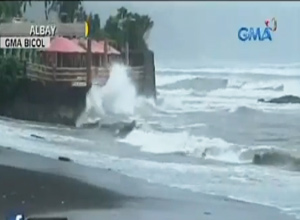Filtered By: Scitech
SciTech
Eating the shoreline slowly: How a storm surge destroys homes, towns
By KIM LUCES, GMA News

Storm surge at the Port of Nato in Sagnay, Camarines Sur, is seen during super typhoon Yolanda's wrath on Friday, November 8. Jake Perez Sr. via YouScoop
As the typhoon leaves, the waters gradually lower and retreat from the shore, revealing its gruesome work—scattered debris, destroyed houses, wrecked towns, and in extreme cases, dead bodies. It's as if the apocalypse has come and gone for such places.
This is how a storm surge works: the abnormal rise in sea levels associated with strong winds and abnormally low atmospheric pressure, brought by a strong typhoon and a normal high tide, said Nathaniel “Mang Tani” Cruz, GMA's resident meteorologist.
“It is a slow process,” he said. “If there is an incoming strong cyclone like Yolanda, the coastal areas near the eye of the storm will experience increasing sea level because of the continuous action of big waves pushing the seawater inland.”
Unlike a tsunami that is triggered by an earthquake or a volcanic eruption under the sea, a storm surge is triggered by strong winds and low atmospheric pressure brought by a strong typhoon.
“So yung nangyari kay Yolanda, as it moves toward the coastal areas of Samar and Leyte, yung almost 300 kph wind generating strong waves, 'yun yung nangtulak sa tubig to move in-land,” Cruz said.
As the waves slowly rise, the land is slowly inundated.
“We are talking here (not just about) a one-foot sea level increase. We're talking about a one-meter, two-meter, three-meter increase. Of course, kahit na ang mga bahay (malapit sa coasts) ay made up of concrete materials, because of the slow continuous action of the waves, (inundated) pa rin sila,” Cruz said.
"So yung bahay mo dati na hindi pinapasok (ng tubig), minsan waist deep, or minsan it can even submerge even the whole house."
Reports of storm surges

A storm surge caught on camera in Bicol. GMANews.tv
Oddly, another report said that more than 50 houses were destroyed by a storm surge in Legazpi City, Albay, rendering several homeless. Albay was not near the eye of the storm, yet storm surges occurred in their area.
The strong north easterly wind flow (Amihan) might have been enhanced by the passing Yolanda south of Albay. This might have resulted to the storm surge reported.
“Karamihan po sa mga nasirang bahay, inanod, nawalan ng dingding at natabunan ng makapal na buhangin problema tuloy ng mga apektadong residente kung saan sila maninirahan,” the report said.
Storm surge-prone areas

A storm surge in Catanduanes. YouScooper Allan Tapado.
Shores with shallow slopes are more prone to storm surges than steep shorelines.
“Pag malalim (ang shoreline) na parang cliff, wala iyon. Kahit tumaas nang tumaas yan, that cliff prevents yung tumataas (na tubig).”
A set of hazard maps done by the National Mapping and Resource Information Authority (NAMRIA) provides information on storm-surge prone shores in some areas of the country.
Parts of the Tacloban City's shoreline were marked to have 'Inundations of more than one-meter to four-meter surges.'
“Even in the US, yung storm surge is one of the hazards na nagpapalala. Sa strong hurricanes, 'yan ang isa sa mga problema nila aside from heavy rainfall, strong winds. (The same goes) here in the Philippines and other areas being affected by strong cyclones,” Cruz said.
He warned that storm surges should not be taken lightly. In extreme cases, storm surges can also take lives, he confirmed. — VC, GMA News
More Videos
Most Popular




